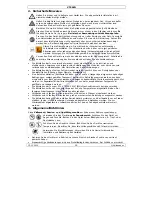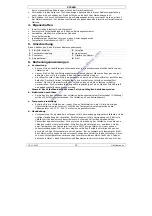
VTSS4N
15.11.2010
©Velleman nv
5
d. Operation
•
Prerequisite for clean joints is the use of suited solder and a correct use of the soldering
station. We recommend the use of solder with a resin flux core. Halogen containing solder
should not be used in any case. Before the first uses, you should tin the new soldering tip.
Switch on the soldering station and apply some solder to the soldering tip at a
temperature of 200°C. Perfect joints are only possible at the right soldering temperature.
When the soldering temperature is too low, the solder will not melt enough causing
unclean (cold) soldering points. At too high temperatures, the solder will burn and the tin-
solder will not flow. Moreover there is the danger of damaging the PCB or the components.
Only when the temperature of the soldering tip is perfectly adapted to the solder will you
have clean joints.
•
The most common soldering alloys used in the electronics industry consist of 60% tin and
40% lead. The operating temperature of this type of solder is detailed below and can vary
from manufacturer to manufacturer. However, to meet RoHS requirements, these solders
are no longer allowed and are replaced by lead-free solders that require a working
temperature which is ±30°C (54°F) higher.
leaded solder
lead-free
Melting point
215°C (419°F)
220°C (428°F)
Normal Operation
270-320°C (518-608°F)
300-360°C (572-680°F)
Production Line Operation
320-380°C (608-716°F)
360-410°C (680-770°F)
•
The included soldering tip consists of copper-plated iron. Used correctly, the soldering tip
has a long durability. Clean the tip immediately before use by rubbing it on the moist
sponge. By doing so residues of unevaporated solder, oxides or other impurities will be
removed.
•
Before you put the soldering iron back into the holder, you should clean it again and apply
some fresh solder. It is important to keep the tip covered with some solder as it will
become passive, not accepting any more solder after a while.
e. Use
•
Thanks to the user-friendliness and the short soldering times this soldering station makes
for carefree soldering. But please be careful! In order to ensure safe use and protect
against damage, you should heed the safety instructions and the warning notices as well
as the legal VDE regulations when soldering.
7.
Tip maintenance
The soldering uses extremely high temperatures. Make sure that the unit is switched off for
maintenance purposes.
Remove the tip and clean it after heavy or moderate use. We recommend cleaning the tip daily if
the station is used frequently.
•
Always tin the tip before returning it to the holder, prior to turning off the station or to storing
it for long periods of time. Wipe the tip on a wet sponge or use our tip cleaner before
activating the device.
•
Using excessive temperatures (more than 400°C or 750°F) will shorten the life span of the tip.
•
Do not exercise excessive pressure on the tip while soldering, as this may cause damage to
the tip.
•
Never clean the tip with a file or with abrasive materials.
•
Do not use flux containing chloride or acid. Use only resinous fluxes.
•
If an oxide film has formed, you should remove it by buffing carefully with a 600-800 grit
emery cloth or by using isopropyl alcohol and consequently applying a new protective layer of
solder.
•
Set the desired temperature after allowing the unit to idle at 250°C for three minutes. The
station will be ready for use once the set temperature is reached.
•
Wet the sponge with nothing but water.
IMPORTANT
Remove and clean the tip daily. Remove excess solder from the barrel nut assembly when
installing a new tip,
www.electronicaembajadores.com





























